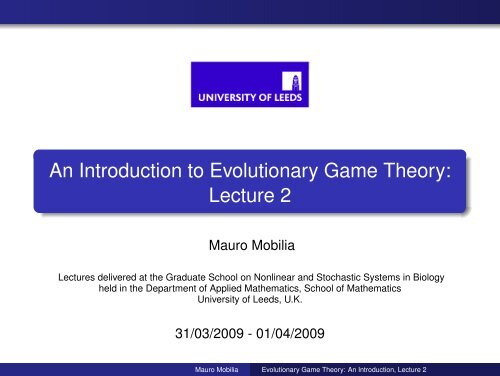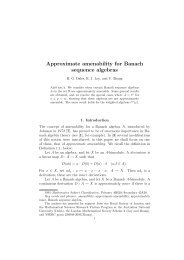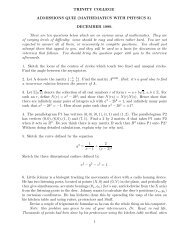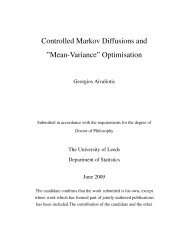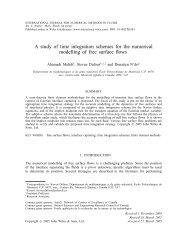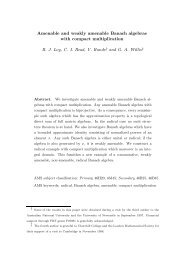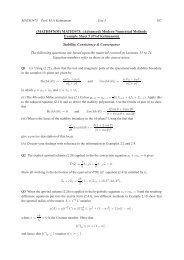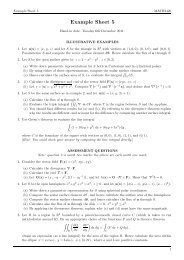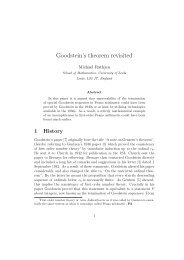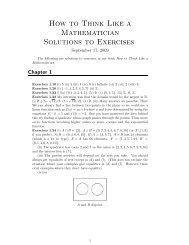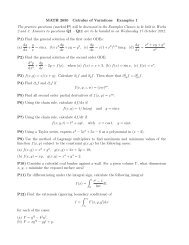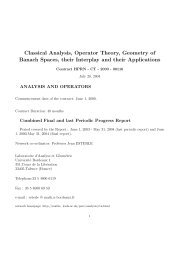An Introduction to Evolutionary Game Theory: Lecture 2 - School of ...
An Introduction to Evolutionary Game Theory: Lecture 2 - School of ...
An Introduction to Evolutionary Game Theory: Lecture 2 - School of ...
- No tags were found...
You also want an ePaper? Increase the reach of your titles
YUMPU automatically turns print PDFs into web optimized ePapers that Google loves.
<strong>An</strong> <strong>Introduction</strong> <strong>to</strong> <strong>Evolutionary</strong> <strong>Game</strong> <strong>Theory</strong>:<strong>Lecture</strong> 2Mauro Mobilia<strong>Lecture</strong>s delivered at the Graduate <strong>School</strong> on Nonlinear and S<strong>to</strong>chastic Systems in Biologyheld in the Department <strong>of</strong> Applied Mathematics, <strong>School</strong> <strong>of</strong> MathematicsUniversity <strong>of</strong> Leeds, U.K.31/03/2009 - 01/04/2009Mauro Mobilia <strong>Evolutionary</strong> <strong>Game</strong> <strong>Theory</strong>: <strong>An</strong> <strong>Introduction</strong>, <strong>Lecture</strong> 2
OutlineThe goal <strong>of</strong> this lecture is <strong>to</strong> give some insight in<strong>to</strong> the following<strong>to</strong>pics:Some Properties <strong>of</strong> the Replica<strong>to</strong>r DynamicsReplica<strong>to</strong>r Equations for 2 × 2 <strong>Game</strong>sMoran Process & <strong>Evolutionary</strong> DynamicsThe Concept <strong>of</strong> Fixation Probability<strong>Evolutionary</strong> <strong>Game</strong> <strong>Theory</strong> in Finite PopulationInfluence <strong>of</strong> Fluctuations on <strong>Evolutionary</strong> DynamicsMauro Mobilia <strong>Evolutionary</strong> <strong>Game</strong> <strong>Theory</strong>: <strong>An</strong> <strong>Introduction</strong>, <strong>Lecture</strong> 2
Replica<strong>to</strong>r DynamicsPopulation <strong>of</strong> Q different species: e 1 ,...,e Q , with frequencies x 1 ,...,x QState <strong>of</strong> the system described by x = (x 1 ,...,x Q ) ∈ S Q , whereS Q = {x;x i ≥ 0,∑ Q i=1 x i = 1}To set up the dynamics, we need a functional expression for thefitness f i (x)Between various possibilities, a very popular choice is:ẋ i = x i(fi (x) −¯f (x) ) ,where, one (out <strong>of</strong> many) possible choices, for the fitness is theexpected pay<strong>of</strong>f: f i (x) = ∑ Q i=1 A ijx jand ¯f (x) is the average fitness: ¯f (x) = ∑ Q ix i f i (x)This choice corresponds <strong>to</strong> the so-called replica<strong>to</strong>r dynamics onwhich most <strong>of</strong> evolutionary game theory is centeredMauro Mobilia <strong>Evolutionary</strong> <strong>Game</strong> <strong>Theory</strong>: <strong>An</strong> <strong>Introduction</strong>, <strong>Lecture</strong> 2
Some Properties <strong>of</strong> the Replica<strong>to</strong>r Dynamics (I)Replica<strong>to</strong>r equations (REs):ẋ i = x i [(Ax) i − x.Ax]Set <strong>of</strong> coupled cubic equations (when x.Ax ≠ 0)Let x ∗ = (x1 ∗,...,x Q ∗ ) be a fixed point (steady state) <strong>of</strong> the REsx ∗ can be (Lyapunov-) stable, unstable, attractive (i.e. there isbasin <strong>of</strong> attraction), asymp<strong>to</strong>tically stable=attrac<strong>to</strong>r ( =stable +attractive), globally stable (basin <strong>of</strong> attraction is S Q )Only possible interior fixed point satisfies (there is either 1 or 0):(Ax ∗ ) 1 = (Ax ∗ ) 2 = ... = (Ax ∗ ) Q = x ∗ .Ax ∗x 1 + ... + x Q = 1Same dynamics if one adds a constant[c j <strong>to</strong> the pay<strong>of</strong>f matrixA = (A ij ): ẋ i = x i [(Ax) i − x.Ax] = x i (Ãx) i −], x.Ãx whereà = (A ij + c j )Mauro Mobilia <strong>Evolutionary</strong> <strong>Game</strong> <strong>Theory</strong>: <strong>An</strong> <strong>Introduction</strong>, <strong>Lecture</strong> 2
Some Properties <strong>of</strong> the Replica<strong>to</strong>r Dynamics (II)Dynamic versus evolutionary stability: connection between dynamicstability (<strong>of</strong> REs) and NE/evolutionary stability?Notions do not perfectly overlap ⇒ Folks Theorem <strong>of</strong> EGT:Let x ∗ = (x1 ∗,...,x Q ∗ ) be a fixed point (steady state) <strong>of</strong> the REsNEs are rest points (<strong>of</strong> the REs)Strict NEs are attrac<strong>to</strong>rsA stable rest point (<strong>of</strong> the REs) is an NEInterior orbit converges <strong>to</strong> x ∗ ⇒ x ∗ is an NEESSs are attrac<strong>to</strong>rs (asymp<strong>to</strong>tically stable)Interior ESSs are global attrac<strong>to</strong>rsConverse statements generally do not hold!For 2 × 2 matrix games x ∗ is an ESS iff it is an attrac<strong>to</strong>rREs with Q strategies can be mapped ( on<strong>to</strong> Lotka-Volterra )equations for Q − 1 species: ẏ i = y i r i + ∑ Q−1j=1 b ijy jReplica<strong>to</strong>r dynamics is non-innovative: cannot generate newstrategiesMauro Mobilia <strong>Evolutionary</strong> <strong>Game</strong> <strong>Theory</strong>: <strong>An</strong> <strong>Introduction</strong>, <strong>Lecture</strong> 2
Replica<strong>to</strong>r Dynamics for 2 × 2 <strong>Game</strong>s (I)2 strategies: say A and BN players: N A are A-players and N B are B-players, N A + N B = NGeneral pay<strong>of</strong>f matrix:vs A BA 1 + p 11 1 + p 12B 1 + p 21 1 + p 22where selection → p ij and the neutral component → 1Frequency <strong>of</strong> A and B strategists is resp.x = N A /N and y = N B /N = 1 − xFitness (expected pay<strong>of</strong>f) <strong>of</strong> A and B strategists is resp.f A (x) = p 11 x + p 12 (1 − x) + 1 and f B (x) = p 21 x + p 22 (1 − x) + 1Average fitness: ¯f (x) = xf A (x) + (1 − x)f B (x)Mauro Mobilia <strong>Evolutionary</strong> <strong>Game</strong> <strong>Theory</strong>: <strong>An</strong> <strong>Introduction</strong>, <strong>Lecture</strong> 2
Replica<strong>to</strong>r Dynamics for 2 × 2 <strong>Game</strong>s (II)Replica<strong>to</strong>r dynamics:dxdt= x[f A (x) −¯f (x)] = x(1 − x)[f A (x) − f B (x)]= x(1 − x)[x(p 11 − p 21 ) + (1 − x)(p 12 − p 22 )]xy = x(1 − x): interpreted as the probability that A and B interactf A (x) − f B (x) = x(p 11 − p 12 ) + (1 − x)(p 12 − p 22 ): says thatreproduction (“success”) depends on the difference <strong>of</strong> fitnessEquivalent pay<strong>of</strong>f matrix (A i1 → A i1 − p 11 , A i2 → A i2 − p 22 ), withµ A = p 21 − p 11 and µ B = p 12 − p 22 :vs A BA 1 1 + µ AB 1 + µ B 1dxdt = x(1 − x)[−xµ A + (1 − x)µ B ] = x(1 − x)[µ B − (µ A + µ B )x]⇒ For 2 × 2 games, the dynamics is simple: no limit cycles, nooscillations, no chaotic behaviourMauro Mobilia <strong>Evolutionary</strong> <strong>Game</strong> <strong>Theory</strong>: <strong>An</strong> <strong>Introduction</strong>, <strong>Lecture</strong> 2
Replica<strong>to</strong>r Dynamics for 2 × 2 <strong>Game</strong>s (III)dxdt = x(1 − x)[µ B − (µ A + µ B )x]1µ A > 0 and µ B > 0: Hawk-Dove gamex ∗ =µ Bµ A +µis stable (attrac<strong>to</strong>r, ESS) interior FPB2µ A > 0 and µ B < 0: Prisoner’s DilemmaB always better <strong>of</strong>f, x ∗ = 0 is ESS3µ A < 0 and µ B < 0: Stag-Hunt <strong>Game</strong>Either A or B can be better <strong>of</strong>f, i.e. x ∗ = 0 and x ∗ = 1 are ESS.x ∗ =µ Bµ A +µis unstable FP (non-ESS)B4µ A < 0 and µ B > 0: Pure Dominance ClassA always better <strong>of</strong>f, x ∗ = 1 is ESSMauro Mobilia <strong>Evolutionary</strong> <strong>Game</strong> <strong>Theory</strong>: <strong>An</strong> <strong>Introduction</strong>, <strong>Lecture</strong> 2
Some Remarks on Replica<strong>to</strong>r DynamicsFor x small: ẋ = µ B xdxdt = x(1 − x)[µ B − (µ A + µ B )x]For x ≈ 1: ẏ = (d/dt)(1 − x) = µ A (1 − x)Thus, the stability <strong>of</strong> x ∗ = 0 and x ∗ = 1 simply depends on the sign <strong>of</strong>µ B and µ A , respectively<strong>An</strong>other popular dynamics is the so-called “adjusted replica<strong>to</strong>rdynamics”, for which the equations read:dxdt= x f [ ]A(x) −¯f (x)fA (x) − f= x(1 − x)B (x)¯f (x) ¯f (x)These equations equations share the same fixed points with the REs.In general, replica<strong>to</strong>r dynamics and adjusted replica<strong>to</strong>r dynamics giverise <strong>to</strong> different behaviours. However, for 2 × 2 games: samequalitative behaviourMauro Mobilia <strong>Evolutionary</strong> <strong>Game</strong> <strong>Theory</strong>: <strong>An</strong> <strong>Introduction</strong>, <strong>Lecture</strong> 2
S<strong>to</strong>chastic Dynamics & Moran Process<strong>Evolutionary</strong> dynamics involves a finite number <strong>of</strong> discrete individuals⇒ “Microscopic” s<strong>to</strong>chastic rules given by the Moran processMoran Process is a Markov birth-death process in 4 steps:2 species, i individuals <strong>of</strong> species A and N − i <strong>of</strong> species B1<strong>An</strong> individual A could be chosen for birth and death withprobability (i/N) 2 . The number <strong>of</strong> A remains the same2<strong>An</strong> individual B could be chosen for birth and death withprobability ((N − i)/N) 2 . The number <strong>of</strong> B remains the same3<strong>An</strong> individual A could be chosen for reproduction and a Bindividual for death with probability i(N − i)/N 2 . For this event:i → i + 1 and N − i → N − 1 − i4<strong>An</strong> individual B could be chosen for reproduction and a Aindividual for death with probability i(N − i)/N 2 . For this event:i → i − 1 and N − i → N + 1 − iMauro Mobilia <strong>Evolutionary</strong> <strong>Game</strong> <strong>Theory</strong>: <strong>An</strong> <strong>Introduction</strong>, <strong>Lecture</strong> 2
S<strong>to</strong>chastic Dynamics & Moran Process<strong>Evolutionary</strong> dynamics given by the Moran process: Markovbirth-death process in 4 stepsThere are two absorbing states in the Moran process: all-B and all-AWhat is the probability F i <strong>of</strong> ending in a state with all A (i = N) startingfrom i individuals A? For i = 1, F 1 is the “fixation” probability <strong>of</strong> ATransition from i → i + 1 given by rate α iTransition i → i − 1 given by rate β iF i = β i F i−1 + (1 − α i − β i )F i + α i F i+1 , for i = 1,...,N − 1F 0 = 0 and F N = 1Mauro Mobilia <strong>Evolutionary</strong> <strong>Game</strong> <strong>Theory</strong>: <strong>An</strong> <strong>Introduction</strong>, <strong>Lecture</strong> 2
Moran Process & Fixation ProbabilityWhat is the fixation probability F 1 <strong>of</strong> A individuals?F i = β i F i−1 + (1 − α i − β i )F i + α i F i+1 , for i = 1,...,N − 1F 0 = 0 and F N = 1Introducing g i = F i − F i−1 (i = 1,...,N − 1), one notes that ∑ N i=1 g i = 1and g i+1 = γ i g i , where γ i = β i /α i ⇒ one recovers a classic results onMarkov chains: F i = 1+∑i−1 j=1 ∏j k=1 γ k1+∑ N−1j=1 ∏j k=1 γ k1⇒ Fixation probability <strong>of</strong> species A is F A = F 1 =1+∑ N−1j=1 ∏j k=1 γ kAs i = 0 and i = N are absorbing states ⇒always absorption (all-A or all-B) ⇒ Fixation probability <strong>of</strong> species Bis F B = 1 − F N−1 =∏ N−1k=1 γ k1+∑ N−1j=1 ∏j k=1 γ kMauro Mobilia <strong>Evolutionary</strong> <strong>Game</strong> <strong>Theory</strong>: <strong>An</strong> <strong>Introduction</strong>, <strong>Lecture</strong> 2
Fixation in the Neutral & Constant Fitness CasesFixation Probabilities:1F A = and F1+∑ N−1B = F A ∏ N−1j=1 ∏j k=1 γ k=1 γ k, with γ i = β i /α ikWhen α i = β i = γ i = 1, this is the neutral case where there is noselection but only random drift:F A =F B =1/NThis means that the chance that an individual will generate alineage which will inheritate the entire population is 1/NCase where A and B have constant but different fitnesses, f A = rfor A and f B = 1 for B, α i =ri(N−i)N(N+(r−1)i) and β i =i(N−i)N(N+(r−1)i)1−r −1Thus, F A = and F1−r −N B = 1−r1−r NIf r > 1, F A > N −1 for N ≫ 1: selection favours the fixation <strong>of</strong> AIf r < 1, F B > N −1 for N ≫ 1: selection favours the fixation <strong>of</strong> BMauro Mobilia <strong>Evolutionary</strong> <strong>Game</strong> <strong>Theory</strong>: <strong>An</strong> <strong>Introduction</strong>, <strong>Lecture</strong> 2
<strong>Evolutionary</strong> <strong>Game</strong>s in Finite Populations (I)Finite population <strong>of</strong> 2 species: i individuals <strong>of</strong> species A and N − iindividuals <strong>of</strong> species B interact according <strong>to</strong> the pay<strong>of</strong>f matrix:vs A BA a bB c dProbability <strong>to</strong> draw a A and B is i/N and (N − i)/N, respectively ⇒Probability that a given individual A interacts with another A is(i − 1)/(N − 1)Probability that a given individual A interacts with a B is(N − i)/(N − 1)Probability that a given individual B interacts with another B is(N − i − 1)/(N − 1)Probability that a given individual B interacts with a A is i/(N − 1)The states i = 0 (All-A) and i = N (All-B) are absorbingExpected pay<strong>of</strong>f for A and B, respectively:Ei A a(i − 1) + b(N − i)=N − 1andEi B ci + d(N − i − 1)=N − 1Mauro Mobilia <strong>Evolutionary</strong> <strong>Game</strong> <strong>Theory</strong>: <strong>An</strong> <strong>Introduction</strong>, <strong>Lecture</strong> 2
<strong>Evolutionary</strong> <strong>Game</strong>s in Finite Populations (II)() −1F A = 1 + ∑ N−1j=1 ∏j k=1 γ k and FB = F A ∏ N−1k=1 γ k, with γ i = β i /α iE Ai= a(i−1)+b(N−i)N−1and EiB = ci+d(N−i−1)N−1Expected pay<strong>of</strong>fs E A,Biare usually interpreted as fitness.Recent idea (Nowak et al.): Introduce a parameter w accounting forbackground random drift contribution <strong>to</strong> fitness f Aif Ai= 1 − w + wEi A and fiB = 1 − w + wEiBfor A and f Bifor BAverage fitness: ¯f = (i/N)fiA + (1 − (i/N))fiBParameter w measures the intensity <strong>of</strong> selection: w = 0 ⇒ noselection (only random drift), w = 1 ⇒ only selection, w ≪ 1 ⇒ “weakselection”Consider a Moran process with frequency-dependent hopping rates:α i = f iA ( )( )i N − iand β i = f B ( )( )i i N − i⇒ γ i = f iB¯f N N¯f N NfiA()Thus, F A = 1/ 1 + ∑ N−1j=1 ∏j k=1 (f k B/f k A) and F B = F A ∏ N−1k=1 (f k B/f k A)Mauro Mobilia <strong>Evolutionary</strong> <strong>Game</strong> <strong>Theory</strong>: <strong>An</strong> <strong>Introduction</strong>, <strong>Lecture</strong> 2
Influence <strong>of</strong> Fluctuations on <strong>Evolutionary</strong> Dynamics (I)(F A = 1 + ∑ N−1j=1 ∏j i=1f AiFixation ) Probabilities:−1and F B = F A ∏ N−1i=1f Bif Ai= 1 − w + w a(i−1)+b(N−i)N−1and f Bi(fBi/fiA ), with= 1 − w + w ci+d(N−i−1)N−1Does selection favour fixation <strong>of</strong> A? Yes, only if F A > 1/NIn the weak selection limit (w → 0):F A ≈N1 [1 −w6({a + 2b − c − 2d}N − {2a + b + c − 4d}) ] −1Thus, F A > 1/N if a(N − 2) + b(2N − 1) > c(N + 1) + 2d(N − 2)N = 2 b > cN = 3 a + 5b > 2(2c + d)N = 4 2a + 7b > 5c + 4d... ...N ≫ 1 a + 2b > c + 2dFor large N, F A > 1/N if a + 2b > c + 2dMauro Mobilia <strong>Evolutionary</strong> <strong>Game</strong> <strong>Theory</strong>: <strong>An</strong> <strong>Introduction</strong>, <strong>Lecture</strong> 2
Influence <strong>of</strong> Fluctuations & Finite-Size Effects (II)In the weak selection limit (w → 0):F A ≈N1 [1 −w6({a + 2b − c − 2d}N − {2a + b + c − 4d}) ] −1For large N, F A > 1/N if a + 2b > c + 2dConsequences <strong>of</strong> finite-size fluctuations?Reconsider a 2 × 2 game with a > c and b < d (“Stag-Hunt game”):Rational game: all-A and all-B are strict-NE and ESSReplica<strong>to</strong>r Dynamics: all-A & all-B attrac<strong>to</strong>rs and x ∗ =an unstable interior rest point (NE, but not ESS)d−ba−c+d−b isIn finite (yet large) population (s<strong>to</strong>chastic Moran process, weakselection): The condition a − c > 2(d − b) <strong>to</strong> favour fixation <strong>of</strong> Aleads <strong>to</strong> x ∗ < 1/3- If the unstable rest point x ∗ occurs at frequency < 1/3, in a largeyet finite population and for w ≪ 1, selection favours the fixation <strong>of</strong> A- Probability that a single A takes over the entire population <strong>of</strong> N − 1individuals B is greater than 1/NMauro Mobilia <strong>Evolutionary</strong> <strong>Game</strong> <strong>Theory</strong>: <strong>An</strong> <strong>Introduction</strong>, <strong>Lecture</strong> 2
Influence <strong>of</strong> Fluctuations & Finite-Size Effects (II)In the weak selection limit (w → 0):F A ≈N1 [1 −w6({a + 2b − c − 2d}N − {2a + b + c − 4d}) ] −1For large N, F A > 1/N if a + 2b > c + 2dConsequences <strong>of</strong> finite-size fluctuations?Reconsider a 2 × 2 game with a > c and b < d (“Stag-Hunt game”):Rational game: all-A and all-B are strict-NE and ESSReplica<strong>to</strong>r Dynamics: all-A & all-B attrac<strong>to</strong>rs and x ∗ =an unstable interior rest point (NE, but not ESS)In finite (yet large) population (s<strong>to</strong>chastic Moran process, weakselection): The condition a − c > 2(d − b) <strong>to</strong> favour fixation <strong>of</strong> Aleads <strong>to</strong> x ∗ < 1/3d−ba−c+d−b isMauro Mobilia <strong>Evolutionary</strong> <strong>Game</strong> <strong>Theory</strong>: <strong>An</strong> <strong>Introduction</strong>, <strong>Lecture</strong> 2
Influence <strong>of</strong> Fluctuations & Finite-Size Effects (III)In the weak selection limit (w → 0, 2 species systems):F A ≈N1 [1 −w6({a + 2b − c − 2d}N − {2a + b + c − 4d}) ] −1Previous result hints that the concept <strong>of</strong> evolutionary stability shouldbe modified <strong>to</strong> account for finite-size fluctuations ⇒ leads <strong>to</strong> theconcept <strong>of</strong> ESS N : A finite population <strong>of</strong> B is evolutionary stable isevolutionary stable against a second species A if1The fitness <strong>of</strong> B is greater than that <strong>of</strong> A, i.e. fiB > fi A , ∀i. Thismeans: “selection opposes A invading B”2F A < 1/N, implying that selection opposes A replacing BThis leads <strong>to</strong> the criteria for evolutionary stability <strong>of</strong> B:Determinsitic (N = ∞)S<strong>to</strong>chastic (N finite)(1) d > b (d − b)N > 2d − (b + c)(2) if b = d, then c > a c(N + 1) + 2d(N − 2) > a(N − 2) + b(2N − 1)Mauro Mobilia <strong>Evolutionary</strong> <strong>Game</strong> <strong>Theory</strong>: <strong>An</strong> <strong>Introduction</strong>, <strong>Lecture</strong> 2
Influence <strong>of</strong> Fluctuations & Finite-Size Effects (III)In the weak selection limit (w → 0, 2 × 2 games):F A ≈N1 [1 −w6({a + 2b − c − 2d}N − {2a + b + c − 4d}) ] −1Criteria for evolutionary stability <strong>of</strong> B in a population <strong>of</strong> size N:Determinsitic (N = ∞)S<strong>to</strong>chastic (N finite)(1) d > b (d − b)N > 2d − (b + c)(2) if b = d, then c > a c(N + 1) + 2d(N − 2) > a(N − 2) + b(2N − 1)Conditions for evolutionary stability depend on the population size:B is ESS N if N = 2 N ≫ 1 (finite)Condition (1): c > b d > bCondition (2): c > b x ∗ =a−c+d−b d−b For small N, the traditional ESS conditions are neither necessarynor sufficient <strong>to</strong> guarantee evolutionary stabilityFor large N, the traditional ESS conditions are necessary but notsufficient <strong>to</strong> guarantee evolutionary stabilityMauro Mobilia <strong>Evolutionary</strong> <strong>Game</strong> <strong>Theory</strong>: <strong>An</strong> <strong>Introduction</strong>, <strong>Lecture</strong> 2
OutlookIn this set <strong>of</strong> lectures dedicated <strong>to</strong> an introduction <strong>to</strong> evolutionarygame theory, we have discussedSome concepts <strong>of</strong> classic (rational) game theory which wereillustrated by a series <strong>of</strong> examples (hawk-doves, prisoner’sdilemma and stag-hunt games)Notion <strong>of</strong> evolutionary dynamics via the concept <strong>of</strong> fitnessReplica<strong>to</strong>r dynamics and discussed its properties: connectionbetween dynamic stability, NEs and ESSReplica<strong>to</strong>r dynamics for 2 × 2 games: classificationS<strong>to</strong>chastic evolutionary dynamics according <strong>to</strong> the MoranprocessFixation probability as a Markov chain problemFixation probability for (a) the neutral case, (b) the case withconstant fitness, (c) 2 × 2 games with finite populationsInfluence <strong>of</strong> fluctuations: fixation and new criteria for evolutionarystability (ESS N for 2 × 2 games)Mauro Mobilia <strong>Evolutionary</strong> <strong>Game</strong> <strong>Theory</strong>: <strong>An</strong> <strong>Introduction</strong>, <strong>Lecture</strong> 2
OutlookFurther <strong>to</strong>pics and some open problems (non-exhaustive list):Replica<strong>to</strong>r dynamics for Q × Q games:For Q ≥ 3: Replica<strong>to</strong>r equations ⇒ cycles, oscillations, chaos(Q > 3), ...Spatial degrees <strong>of</strong> freedom and role <strong>of</strong> mobility (PDE): patternformationQ × Q games with mutationsS<strong>to</strong>chastic evolutionary dynamics:S<strong>to</strong>chastic evolutionary game theory on lattices and graphsCombined effects <strong>of</strong> mobility, fluctuations, and selectionFor Q × Q games, with Q ≥ 3:Diffusion approximation (Fokker-Planck equation)Fixation and extinction times (e.g. as first-passage problems)Generalization <strong>of</strong> the concept <strong>of</strong> ESS NMauro Mobilia <strong>Evolutionary</strong> <strong>Game</strong> <strong>Theory</strong>: <strong>An</strong> <strong>Introduction</strong>, <strong>Lecture</strong> 2


